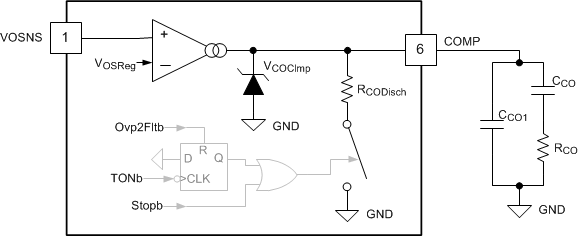SLUSD37E October 2017 – November 2019 UCC28056
PRODUCTION DATA.
- 1 Features
- 2 Applications
- 3 Description
- 4 Revision History
- 5 Device Comparison Tables
- 6 Pin Configuration and Functions
- 7 Specifications
-
8 Detailed Description
- 8.1 Overview
- 8.2 Functional Block Diagram
- 8.3
Feature Description
- 8.3.1 CrM/DCM Control Principle
- 8.3.2 Line Voltage Feed-Forward
- 8.3.3 Valley Switching and CrM/DCM Hysteresis
- 8.3.4 Transconductance Amplifier with Transient Speed-up Function
- 8.3.5 Faults and Protections
- 8.3.6 High-Current Driver
- 8.4 Controller Functional Modes
- 9 Application and Implementation
- 10Power Supply Recommendations
- 11Layout
- 12Device and Documentation Support
- 13Mechanical, Packaging, and Orderable Information
Package Options
Mechanical Data (Package|Pins)
- DBV|6
Thermal pad, mechanical data (Package|Pins)
Orderable Information
8.3.4 Transconductance Amplifier with Transient Speed-up Function
The voltage error amplifier is a transconductance amplifier. Voltage loop compensation connects from the error amplifier output, COMP, to ground. The recommended type-2 compensation network is shown in . For loop-stability purposes, the controller calculates the compensation network values based on small-signal perturbations of the output voltage using the nominal transconductance gain gM.
 Figure 22. Transconductance Error Amplifier with Typical Compensation Network
Figure 22. Transconductance Error Amplifier with Typical Compensation Network To improve the transient response to large perturbations, the error amplifier gain increases by a factor of six times (6×) when the error amplifier input deviates more than ±3% from the nominal regulation voltage, VOSReg. This increase allows faster charging and discharging of the compensation components to recover from step changes in load current.